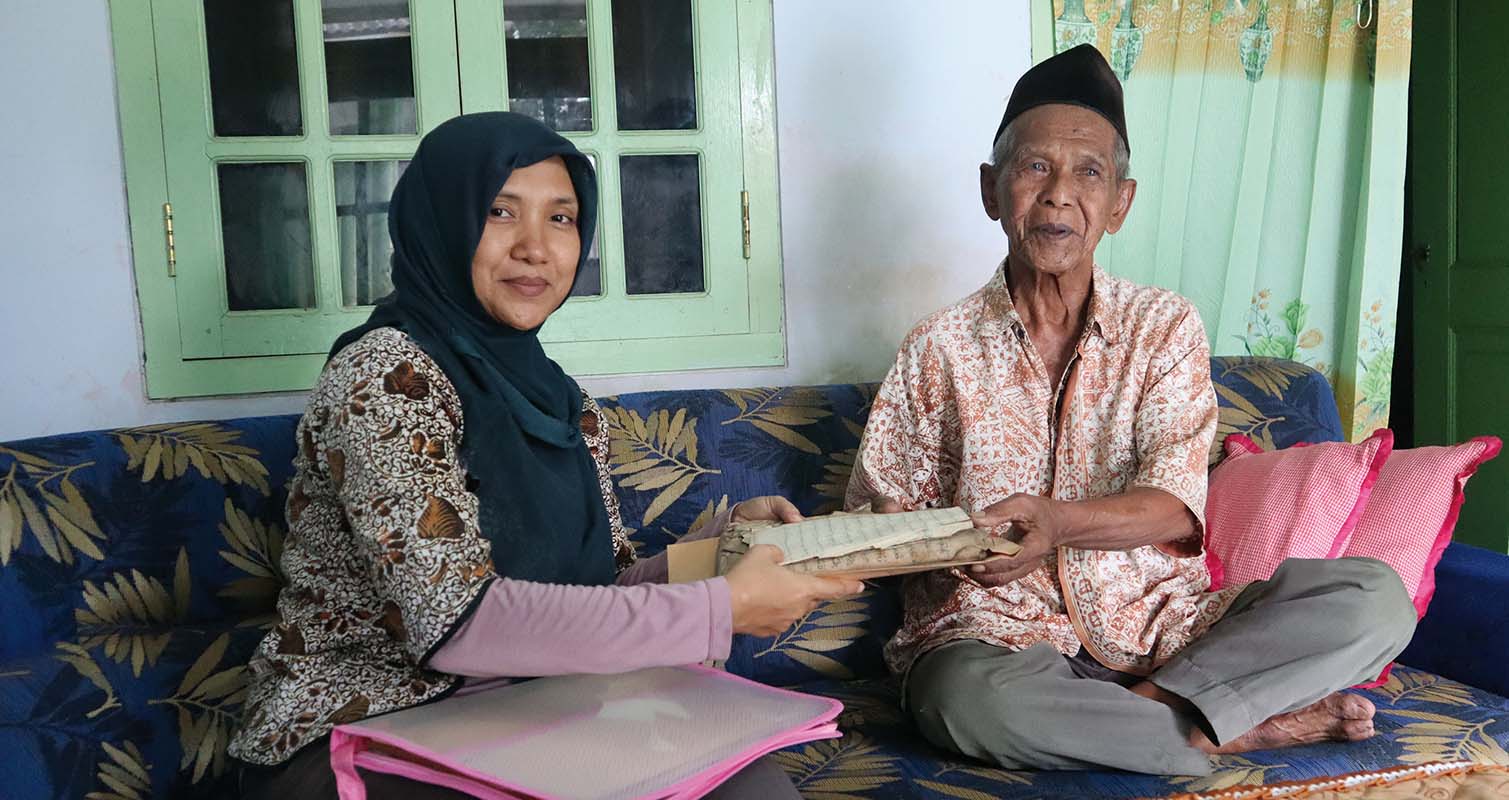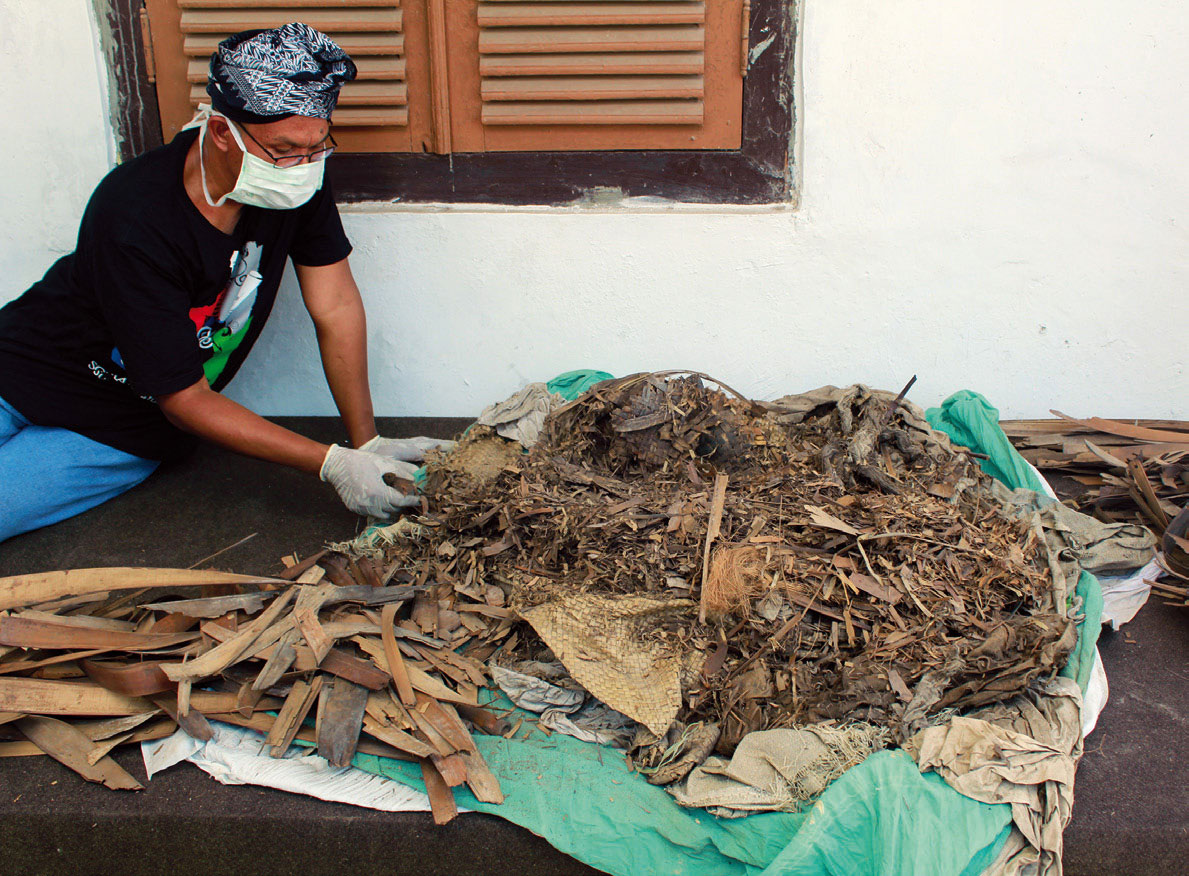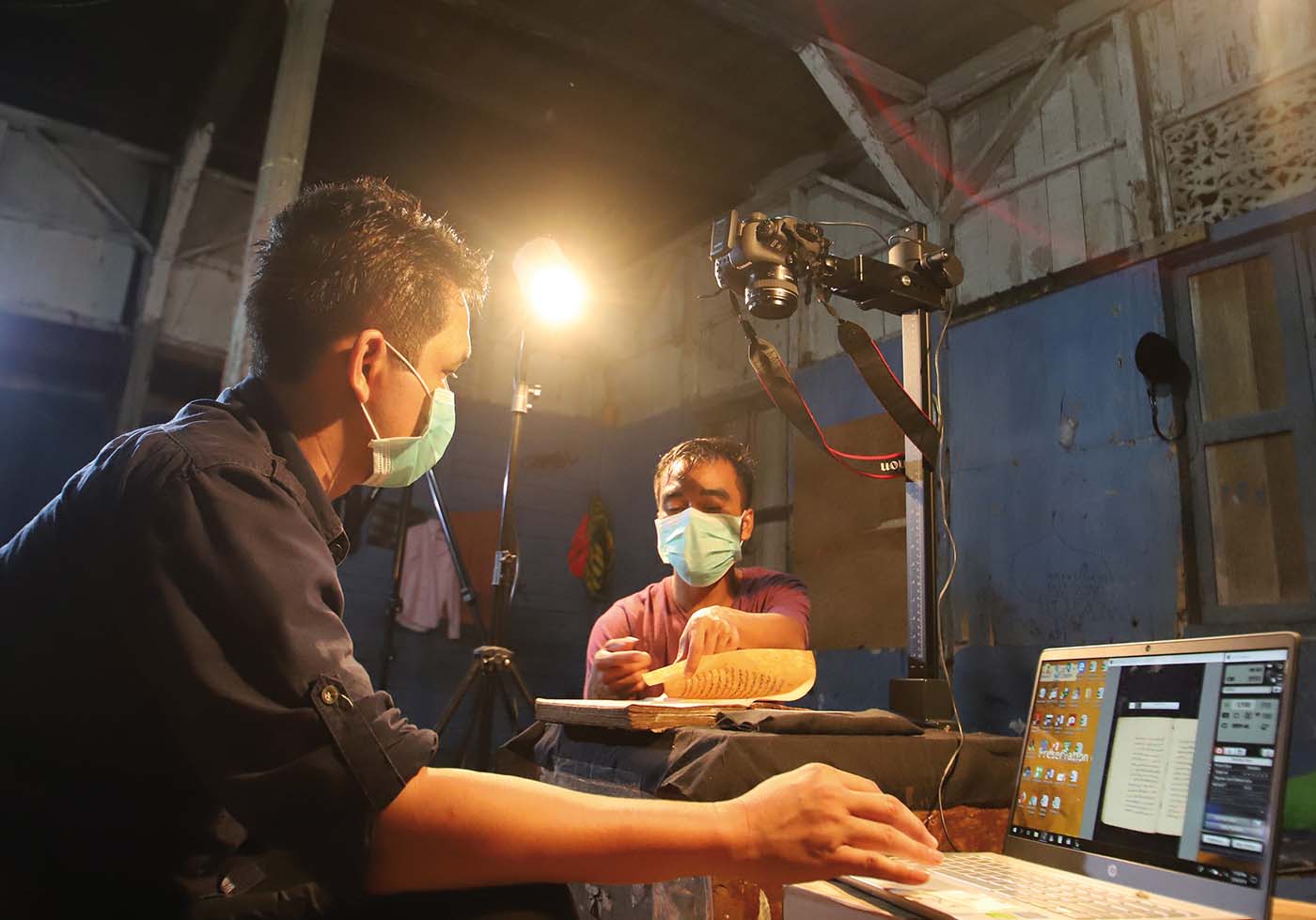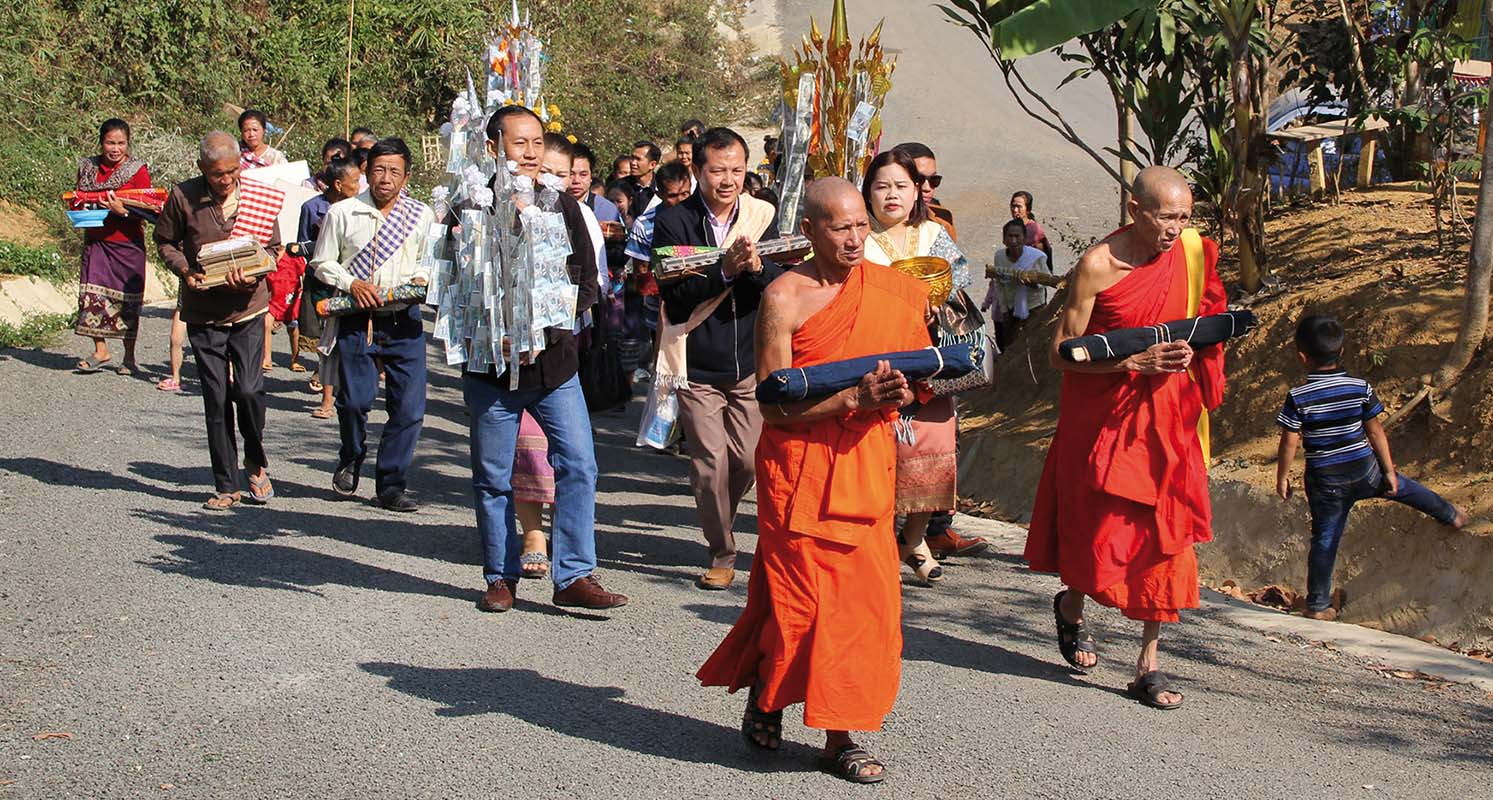Preserving manuscripts for future generations. The digital repository of endangered and affected manuscripts in Southeast Asia (DREAMSEA)
In Southeast Asia a large number of handwritten manuscripts abound that contain a wide array of, mostly, religious subjects and that are written in a large variety of languages and scripts. A substantial number of these manuscripts have been preserved in public collections inside and outside Southeast Asia, but a surprisingly large amount of these culturally significant objects are in private hands or stored in semi-public collections of institutions, such as palaces, temples and other places of religious study and worship in the region. Deliberate or unintended neglect, climate, natural disasters and more, put an increasing number of manuscripts in jeopardy. The DREAMSEA programme was set up to ensure that the contents of the manuscripts are preserved for present and future generations.
Lost forever
In the largest country in Southeast Asia, Indonesia, the number of manuscripts in private collections alone is staggering. They may be found from Aceh on the tip of Sumatra all the way east to Papucsmca, and from the Minahassa in the north to the royal palaces of Central Java. In mainland Southeast Asia manuscript lovers and guardians of temples have established repositories to store their highly valued and often venerated heirlooms. There is a network of Buddhist convents built around Myanmar, Thailand, Laos, Vietnam and Cambodia, that include small pavilions where the sacred texts are kept. The manuscript cultures in the region, with the practice of copying texts by hand, continued most pertinently in the religious culture, whereas the more secular parts of social life were informed with texts that were much less involved in rituals and could be multiplied and preserved in other ways. We encounter similar trends in insular Southeast Asia where small Islamic educational centres frequently have their repositories. At the same time, Balinese temples, Chinese shrines and Christian institutions will have retained some of their cultural heritage of handwritten documents.
Many of these manuscripts are not preserved in a professional way, which means that they are often the victim of simple unintended neglect. The humid tropical weather conditions we encounter in large parts of the region are detrimental for the preservation of manuscripts, especially when they are written on paper. Insects and other pests, too, have that effect as these animals feed on the organic materials. Natural and social disasters further add to the circumstances that make handwritten manuscripts in Southeast Asia highly endangered, and put their physical existence in jeopardy.

Mrs Wiwin Indiarti, S.S. M.Hum. with Mbah Haliyah in Banyuwangi at the tip of East Java, Indonesia; returning one of his manuscripts after digitisation.
The manuscripts frequently remain the only witnesses of a substantial number of texts that are still unedited and therefore unknown in any other form. This means that when the manuscripts disappear or are destroyed, their contents are lost forever, not only for scholars but also for the general interested public. The loss of these texts means that part of the diversity in the cultural and religious outlook of the peoples in the region will disappear with them. Within the religious and cultural traditions there is a tendency for small groups, with their own exegetic practices, to be regarded as deviant by the majorities who are informed by the transnational mainstream religious practices that are considered to be in agreement with ‘modern times’.
Digitisation, metadata and preservation
The DREAMSEA programme was set up against the background of the ongoing degradation of cultural diversity and has the aim to ensure that the contents of the manuscripts are preserved for present and future generations. We have embarked on an ambitious course comprising the digitisation of as many endangered manuscripts as possible. It will involve storing these surrogate images on servers and converting them to other formats in the future. We will then upload these images to an open-access database, providing reliable metadata about the manuscripts to assist users of the database to form an impression of the physical manuscripts and supply information for their research. Although not included as one of our main aims, we also develop efforts to preserve the physical manuscripts by advising their owners about better ways to store and handle them. DREAMSEA has its regional office at the premises of the Center for the Study of Islam and Society (PPIM) of the Syarif Hidayatulah State Islamic University in Jakarta. The programme is executed through a cooperation between the Centre for the Study of Manuscripts Cultures (CSMC) at the University of Hamburg in Germany, PPIM, and the Hill Museum and Manuscript Library (HMML), which is based in Minnesota, USA. The programme is funded by a generous grant from the Arcadia Foundation in the United Kingdom.
The fact that Southeast Asian manuscripts were written using a large variety of scripts and languages makes the execution of the programme quite challenging. One of the most complex issues is the metadata, which needs to be accurate and correct. To execute this in a satisfactory manner, we call in the help of experts who are informed and/or part of the manuscript traditions themselves to write down and check the information about the physical characteristics of the manuscript and the text(s) contained in them. In Indonesia, DREAMSEA works together with members of the Indonesian Association for Nusantara Manuscripts (MANASSA, Masyarakat Pernaskahan Nusantara); they live all over the country and use their networks of manuscript owners and enthusiasts to help us detect and negotiate access to endangered collections in private hands. In mainland Southeast Asia, this kind of network does not exist, and DREAMSEA relies on help from academics and other groups of manuscript experts. DREAMSEA also cooperates with the National Library of Indonesia staff to assist manuscript owners with improved preservation methods for their collections.

A so-called 'buk' in Indramayu on Java's north coast. In this region, old manuscripts are not destroyed but put in a bag. The bag is used during ceremonies, but is never opened, so no one knows its contents. DREAMSEA was allowed to have one 'buk' opened to digitise its contents, as far as possible. Photograph DREAMSEA.
In a nutshell, the DREAMSEA proactive procedure is as follows. DREAMSEA or MANASSA staff members approach manuscript owners, or they contact DREAMSEA or MANASSA themselves. After this initial step, manuscript owners or MANASSA members may submit a proposal to the DREAMSEA office in Jakarta for the digitisation of their manuscripts. The proposal is assessed and, if approved, a mission is sent to the owner to photograph the manuscripts. A team usually consists of 5 persons: one photographer, one assistant photographer, an academic expert, and assistant academic expert and an assistant. Where necessary, manuscripts are cleaned before being photographed. The cleaning of the manuscripts needs to be done very carefully so as not to damage them even more. They are written on a large variety of materials ranging from different types of paper, palm-leaf, bamboo and tree bark. These writing supports come in all kinds of sizes, from extremely small to large scrolls of many meters long. To ensure that the team records crucial information about the manuscript themselves, the place where they are kept, their owners, and how they were used and transmitted, a special photographer cum videographer is part of the team. The information gathered is used to form a picture of the present manuscript situation, which is used to design a strategy to help owners better preserve their manuscripts. At various stages during the process, the metadata and manuscript images are checked for quality. The metadata is translated into English and, along with the images, is sent to HMML in Minnesota to be uploaded to the DREAMSEA cloud. This quality control is complex and very time consuming because of the large number of languages and scripts that need to be deciphered and, of course, due to the enormous diversity of manuscript contents. We regularly encounter incomplete manuscripts, often with missing pages at the start, which makes it very difficult to quickly identify texts contained in the manuscripts. Particularly in the case of the quite common Multiple-Text Manuscripts (MTMs), i.e., manuscripts containing a variety of (fragments of) texts, the identification of the items can be a very time-consuming effort. Frequently, the texts in the manuscripts are without title, and the DREAMSEA staff has to provide one, so that researchers at least get an idea of what type of text it is. As a matter of course, these provisional titles may be inaccurate, and other mishaps can also occur. Therefore, we invite researchers and other interested parties who find mistakes in the online repository to report such inaccuracies, so that we can improve the catalogue. So far manuscripts have been digitised from Luang Prabang in Laos, Lamphun in Thailand and in many places in Indonesia in Sumatra, Java, Sulawesi and Bali. At present, more than 150.000 images have been processed, of which more than 27.000 are now available in the DREAMSEA Cloud.
Cultural heritage and diversity
Texts in Southeast Asian manuscripts have lost much of their initial practical value and relevance for everyday life, and much information can be gathered from books and, of course, from the internet; yet, as mentioned above, a substantial number of texts have never been edited nor have they appeared in book form, and therefore may reveal hidden treasures that add to the knowledge we have of the past. The manuscripts that act as containers of the texts can tell us much about how texts went from one place to the other and reveal the intercultural, interreligious and interhuman contacts throughout the region in the (recent) past, and sometimes even in the present since some manuscript cultures are continued. We should not forget that the majority of the manuscripts in the region were made recently and many, if not most of them, are no older than 100 to 150 years. This means that until recently, the contents of these manuscripts were disseminated in manuscript form only. This adds to their value as no other sources are available to tell us what people thought and how they expressed their thoughts in words. Manuscripts also feature prominently in the discovery and revived appraisal of nations’ cultural heritage, but perhaps particularly of specific individual small communities. They are often used as heirlooms of a community’s highly cultured past, that is almost forgotten but is worthy of being preserved and restored.

DREAMSEA staff digitising a paper manuscript in Surau Simaung, West Sumatra, Indonesia, on 9 September 2019.
In its attempts to preserve this cultural heritage and diversity throughout Southeast Asia, DREAMSEA endeavours to find as many manuscripts from as many different backgrounds as possible. This is easier said than done. Not infrequently, people are ignorant about their content and value, or they are embarrassed or secretive about their existence out of fear of ridicule, or even physical threat because others believe the manuscripts contain deviant texts. In each case, we will need to assess whether the manuscripts brought to our attention are indeed endangered. It transpires that most manuscripts brought to us are threatened simply because of the tropical climate and the fact that they are in the hands of people who do not know how to preserve them professionally. The fact alone that they are in private hands is another reason for their endangeredness. Once the collector dies or decides to get rid of his collection, the manuscripts are either lost or end up in private collections that may not be accessible. This fact presented yet another dilemma for us. We had to consider whether to digitise entire collections or only certain parts of them. We solved this issue in a rather practical and straightforward way. Choosing only selected manuscripts would mean that our present-day interests would decide not to include what others in the future might deem to be of crucial importance. Therefore, we decided to digitise entire collections.

Returning manuscripts to the Vat Pak Chaek village temple monastery, by the abbot, novices and lay people from the Pak Chaek village community and the DREAMSEA team of Luang Prabang, Laos, on 9 January 2020.
The digitised manuscripts stay with their owners. As a token of appreciation of their willingness to have their collections digitised and for the very fact that they built these collections, they receive a framed certificate with a picture of one of the manuscripts. They also receive a hard disk with the digital images of their manuscripts, and sometimes we present them with cupboards or boxes to store the collection in a dust-free environment.
Stay informed
Building on a community of stakeholders and a network of informants is crucial to finding the smaller collections of manuscripts and to showing how much fun studying these manuscripts may be. DREAMSEA uses social media to inform the public what is being done and to attract attention for the study and use of handwritten manuscripts. You can connect with us on Facebook, Twitter, and Instagram, whilst more about current and future activities can also be found on the DREAMSEA website.
Dick van der Meij, DREAMSEA's Academic Advisor and Liaison Officer dreamsea.mss@gmail.com
Jan van der Putten, Professor Austronesistik, Universität Hamburg, Primary Investigator (PI) DREAMSEA Jan.van.der.Putten@uni-hamburg.de
DREAMSEA website: https://dreamsea.co
DREAMSEA Blog: http://blog.dreamsea.co
DREAMSEA Repository: https://www.hmmlcloud.org/dreamsea/manuscripts.php
Instagram: @dreamsea_mss (#saveourmanuscripts)
Twitter: @dreamsea_mss (#saveourmanuscripts)
Facebook: https://www.facebook.com/dreamseaproject
YouTube: DREAMSEA Manuscripts